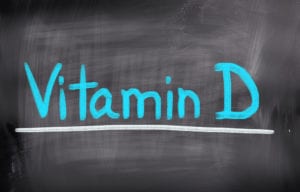Written by Jessica Patella, ND. Sixteen weeks of vitamin D supplementation significantly improved vitamin D levels and arterial stiffness in the participating overweight African Americans, but not in the placebo group.
 African Americans are at an increased risk of low vitamin D levels in the blood 1,2. Recent research has discovered a link between vitamin D deficiency and cardiovascular disease risk, stroke, arterial disease and mortality 1,3-6. Cardiovascular disease is the leading cause of death in African Americans 7, making early detection a key. Arterial stiffness is a predictor of cardiovascular disease and death and therefore is being used as an earlier detection test for heart disease 1,8. Recent research has found that supplementing vitamin D can decrease arterial stiffness in African-American adults 1.
African Americans are at an increased risk of low vitamin D levels in the blood 1,2. Recent research has discovered a link between vitamin D deficiency and cardiovascular disease risk, stroke, arterial disease and mortality 1,3-6. Cardiovascular disease is the leading cause of death in African Americans 7, making early detection a key. Arterial stiffness is a predictor of cardiovascular disease and death and therefore is being used as an earlier detection test for heart disease 1,8. Recent research has found that supplementing vitamin D can decrease arterial stiffness in African-American adults 1.
The research included 70 overweight African Americans (13-45 years) with low vitamin D blood levels (serum 25-hydroxyvitamin D <20 ng/mL). The participants were randomly assigned to a monthly oral supplementation of 18,000 IU vitamin D (about 600 IU/day; n=17), 60,000 IU vitamin D (about 2,000 IU/day, n=18) or 120,000 IU (about 4,000 IU/day, n=18) or placebo (n=17) for 16-weeks 1.
The following results were observed:
Vitamin D blood level increases compared to baseline
| 8-weeks | 16-weeks | |
|---|---|---|
| Placebo | 1.2% | 5.6% |
| About 600 IU/day | 50% | 61.4% |
| About 2,000 IU/day | 91.8% | 126.4% |
| About 4,000 IU/day | 168.4% | 161.7% |
These results indicate an increase in vitamin D with an increase dosage, but it appeared to reach a plateau in the 4,000 IU/day group 1.
Arterial Stiffness- as measured by carotid-femoral Pulse Wave Velocity (PWV)
| Mean change | Significance | |
|---|---|---|
| Placebo | 0.13 m/s | 95% CI, -0.24 to 0.51 m/s |
| About 600 IU/day | 0.02 m/s | 95% CI, -0.34 to 0.38 m/s |
| About 2,000 IU/day | -0.11 m/s | 95% CI, -0.50 to 0.27 m/s |
| About 4,000 IU/day | -0.70 m/s | 95% CI, -1.07 to -0.32 m/s |
A significant downward trend was observed P<0.01
Arterial Stiffness- as measured by carotid-radial Pulse Wave Velocity (PWV)
| Mean change | Significance | |
|---|---|---|
| Placebo | 0.24 m/s | 95% CI, -0.45 to 0.92 m/s |
| About 600 IU/day | 0.09 m/s | 95% CI, -0.54 to 0.73 m/s |
| About 2,000 IU/day | -0.57 m/s | 95% CI, -1.20 to 0.07 m/s |
| About 4,000 IU/day | -0.61 m/s | 95% CI, -1.25 to -0.02 m/s |
A significant downward trend was observed P<0.03
Both of the results of arterial stiffness indicate decreases in arterial stiffness from baseline to week-16, which is an improvement in a main risk factor for cardiovascular disease 1. Results were statistically significant, with decreases in carotid-femoral PWV of -10.4% and -2.0% and carotid-radial PWV of -8.0% vs -7.4% in the 4,000 IU and 2,000 IU per day groups, respectively (both P<0.05) 1.
In conclusion, supplementing vitamin D3 in higher doses (60,000 IU and 120,000 IU) once a month decreased arterial stiffness in a dose-response manner 1. Future research with more participants should be conducted 1.
Source: Raed A, Bhagatwala J, Zhu H, Pollock NK, Parikh SJ, Huang Y, et al. (2017) Dose responses of vitamin D3 supplementation on arterial stiffness in overweight African Americans with vitamin D deficiency: A placebo controlled randomized trial. PLoS ONE 12(12): e0188424. https://doi.org/10.1371/journal.pone.0188424
© 2017 Raed et al. Open access article distributed under the terms of the Creative Commons Attribution License, which permits unrestricted use, distribution, and reproduction in any medium, provided the original author and source are credited.
Click here to read the full text study.
Posted February 1, 2018.
References:
- Raed A, Bhagatwala J, Zhu H, et al. Dose responses of vitamin D3 supplementation on arterial stiffness in overweight African Americans with vitamin D deficiency: A placebo controlled randomized trial. PloS one. 2017;12(12):e0188424.
- Dong Y, Pollock N, Stallmann-Jorgensen IS, et al. Low 25-hydroxyvitamin D levels in adolescents: race, season, adiposity, physical activity, and fitness. Pediatrics. 2010;125(6):1104-1111.
- Martins D, Wolf M, Pan D, et al. Prevalence of cardiovascular risk factors and the serum levels of 25-hydroxyvitamin D in the United States: data from the Third National Health and Nutrition Examination Survey. Archives of internal medicine. 2007;167(11):1159-1165.
- Lee JH, O’Keefe JH, Bell D, Hensrud DD, Holick MF. Vitamin D deficiency: an important, common, and easily treatable cardiovascular risk factor? Journal of the American College of Cardiology. 2008;52(24):1949-1956.
- Pilz S, Dobnig H, Fischer JE, et al. Low vitamin D levels predict stroke in patients referred to coronary angiography. Stroke. 2008;39(9):2611-2613.
- Melamed ML, Muntner P, Michos ED, et al. Serum 25-hydroxyvitamin D levels and the prevalence of peripheral arterial disease: results from NHANES 2001 to 2004. Arteriosclerosis, thrombosis, and vascular biology. 2008;28(6):1179-1185.
- Mozaffarian D, Benjamin EJ, Go AS, et al. Executive summary: heart disease and stroke statistics—2015 update. Circulation. 2015;131(1):434-441.
- Palombo C, Kozakova M. Arterial stiffness, atherosclerosis and cardiovascular risk: Pathophysiologic mechanisms and emerging clinical indications. Vascular pharmacology. 2016;77:1-7.

